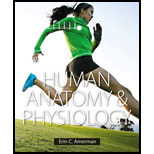
Concept explainers
Which of the following best describes the position of a tissue in the levels of organization of the human body?
Tissues are the most fundamental level of organization.
Tissues are between cells and organs in the levels of organization.
Tissues are the most complex level of organization.
Tissues are between organs and systems in the levels of organization.
Introduction:
Cell is described as the most basic and fundamental unit of life. It is the functional and structural unit. Cells organize themselves into tissues. Tissues are considered to be living fabrics. A particular tissue consists of cells, that are similar to each other in terms of functions.
Answer to Problem 1CYR
Correct answer:
Tissues are considered to be between cells and organs when comparing them according to levels of organization.
Explanation of Solution
Explanation for the correct answer:
Option (b) states that tissues come between cells and organs in the hierarchy of organizational levels. Structurally and functionally similar cells are grouped together, forming tissues. These tissues further group together, forming an organ. An organ carries out a specific function in the body. Hence, option (b) is correct.
Explanation for the incorrect answers:
Option (a) states that tissues are the most fundamental unit in the level of organization. This is false because the cells are the structural, functional, and fundamental units. They are a complete organizational structure performing different functions at a miniature level. So, it is an incorrect option.
Option (c) states that tissues are the most complex ones. This is false as organ systems are the most complex. Different organs form an organ system, performing a specific process in the body. For example, stomach, pancreas, liver, and others come under the digestive system. So, it is an incorrect option.
Option (d) states that tissues between the organs and systems. This is false because tissues are lie between cells and organs. Cells form tissues, tissues form organs, and organs form organ systems. So, it is an incorrect option.
Hence, options (a), (c), and (d) are incorrect.
Therefore, tissues are placed between cells and organs in the levels of organization.
Want to see more full solutions like this?
Chapter 4 Solutions
Human Anatomy & Physiology
- answer questions 1-10arrow_forwardAnswer Question 1-9arrow_forwardEx: Mr. Mandarich wanted to see if the color of light shined on a planthad an effect on the number of leaves it had. He gathered a group ofthe same species of plants, gave them the same amount of water, anddid the test for the same amount of time. Only the color of light waschanged. IV:DV:Constants:Control Gr:arrow_forward
- ethical considerations in medical imagingarrow_forwardPlease correct answer and don't used hand raiting and don't used Ai solutionarrow_forward2. In one of the reactions of the citric acid cycle, malate is oxidized to oxaloacetate. When this reaction is considered in isolation, a small amount of malate remains and is not oxidized. The best term to explain this is a. enthalpy b. entropy c. equilibrium d. free energy e. loss of energyarrow_forward
- 18. The citric acid cycle takes place in a. the chloroplasts b. the cytosol c. the inner mitochondrial membrane d. between the two mitochondrial membranes e. the mitochondrial matrix 40 WILarrow_forward8. Most reactions of anaerobic respiration are similar to a. aerobic respiration b. photosynthesis c. lactic acid fermentation d. alcoholic fermentation e. both c and darrow_forward12. Which of the following molecules can absorb light? a. Pigments b. Chlorophyll c. Rhodopsin d. Carotenoids e. All of the abovearrow_forward
- Which of the following proteins or protein complexes is directly required for the targeting of mitochondrial inner membrane multipass proteins, such as metabolite transporters, whose signal sequence is normally not cleaved after import? OA. TIM22 OB. TIM23 C. OXA OD. Mia40 OE SAMarrow_forwardQUESTION 9 An animal cell has been wounded and has a small rupture in its plasma membrane. Which of the following is more likely to happen next? OA. The cell rapidly cleaves by cytokinesis. OB. The rate of receptor-mediati endocytosis is increased. OC. The rate of exocytosis is increased. OD. The rate of pinocytosis is increased.arrow_forwardFor the a subunit of a trimeric G protein, A. a G-protein-coupled receptor GPCR) acts as a guanine nucleotide exchange factor (GEF), whereas a regulator of G protein signaling (RGS) can act as a GTPase-activating protein (GAP). B. a GPCR acts as a GAP, whereas an RGS can act as a GEF. C. both a GPCR and an RGS can act as a GEF. O D. both a GPCR and an RGS can act as a GAP OE. None of the above.arrow_forward
 Human Biology (MindTap Course List)BiologyISBN:9781305112100Author:Cecie Starr, Beverly McMillanPublisher:Cengage Learning
Human Biology (MindTap Course List)BiologyISBN:9781305112100Author:Cecie Starr, Beverly McMillanPublisher:Cengage Learning Human Physiology: From Cells to Systems (MindTap ...BiologyISBN:9781285866932Author:Lauralee SherwoodPublisher:Cengage Learning
Human Physiology: From Cells to Systems (MindTap ...BiologyISBN:9781285866932Author:Lauralee SherwoodPublisher:Cengage Learning Medical Terminology for Health Professions, Spira...Health & NutritionISBN:9781305634350Author:Ann Ehrlich, Carol L. Schroeder, Laura Ehrlich, Katrina A. SchroederPublisher:Cengage Learning
Medical Terminology for Health Professions, Spira...Health & NutritionISBN:9781305634350Author:Ann Ehrlich, Carol L. Schroeder, Laura Ehrlich, Katrina A. SchroederPublisher:Cengage Learning





